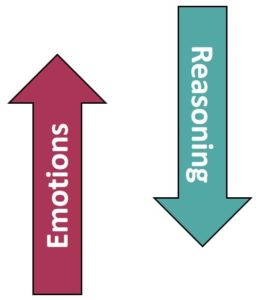Four Ways to Defeat Hijacking

The Army was unprepared for such an event, and thoughtlessly hired Yellow Cab drivers to deliver telegrams to soldiers’ wives back home to inform them that their husbands had been killed in battle.
When Julia Moore, the wife of the battalions’ commander, saw a Yellow Cab driver walk toward her front door and ask for directions so he could deliver the next telegram, she exploded in fear and anger.
But within moments, she brought her emotions under control and bravely volunteered for one of the most painful missions of the war.
Julia’s initial reaction to the Yellow Cab driver was a neurological/emotional process that is commonly known as “amygdala hijacking,” a process that typically involves sudden, intense emotions that trigger an impulsive reaction that is soon regretted.
Most of us have experienced these types of impulsive reactions in our marriages or with our children, relatives or coworkers.
The good news is that there are four simple steps you can use to defeat this destructive dynamic and to take control of intense emotions. After explaining these steps, I will illustrate them with a video clip from the movie, We Were Soldiers, which depicts Julia Moore’s amazing ability to harness the power of intense emotions and use it for good.
A Matter of Nanoseconds
Part of what goes wrong in these situations (and this is only one part) has to do with the wiring of our brains. Instead of meshing smoothly, the various parts of our brain sometimes get out of synch. Here’s one way this happens …
Data from our senses (eyes, ears, touch, etc.) enters the brain through the thalamus, which relays impulses to other parts of the brain, including the amygdala, which is like a filing cabinet that stores our memories of emotional experiences in life and triggers our “flight, fight or freeze” responses to new life experiences.
Due to small differences in the distances to be traveled, impulses arrive at the amygdala a few nanoseconds before they get to the neocortex. If the sensory data triggers an intense emotional memory in the amygdala, those emotions can trigger an impulsive reaction, essentially hijacking our mouth or body before we are able to rationally process the information.
Simple illustration. My wife is terrified of snakes. So if we were walking along the top of a high mountain cliff and she saw a small garter snake beside the trail, she would probably scream and leap ten feet out into thin air before her neocortex reminded her that she can’t fly. But by then it’s too late.
People who have experienced especially painful events, such as failing in school, receiving a demeaning job performance review, seeing their parents divorce or, worst of all, being emotionally, physically or sexually abused are vulnerable to similar impulsive reactions.
Competition in the Brain
That’s just the beginning of our challenges. Using functional neuroimaging, a team of neuroscientists led by Matthew Lieberman discovered another competing relationship between our amygdala, where emotions are processed, and the neocortex, where our rational thinking, language skills and impulse control are located.
They found that when the amygdala is highly stimulated with intense emotions, it utilizes more blood and oxygen than normal, leaving less of both for the neocortex. This deficit causes a corresponding decrease in our capacity for reasoning, problem solving, and impulse control. This can lead to a temporary loss of 10 to 15 IQ points!
Yes, you really do get dumber when you’re highly emotional.
So when someone asks, “What were you thinking?” after an emotional outburst, part of your answer can be, “I was thinking with a lot less brain power than I normally have at my disposal.”
Practical Defenses Against Hijacking
Realizing that emotional hijacking makes it difficult to think clearly, our ministry has developed several simple acrostics to make it easier for you to practice relational skills that enable you to manage your words and actions wisely in stressful situations.
One of these acrostics is set forth in this principle: “To become more self-aware and self-engaging, READ yourself accurately.” This acrostic summarizes four key steps that can help you resist hijacking:
- Recognize your emotions and name them
- Evaluate their source
- Anticipate the consequences of following them
- Direct them on a constructive course
Recognize – What am I feeling?
Neuroimaging as well as practical experience have shown that labeling emotions can help to reduce their intensity and shift more of their management back to the prefrontal cortex.
For example, in a study conducted by Dr. Lieberman, when people attached a word like “angry” to an angry-looking face, neuro-activity in the amygdala, which processes fear, panic and other strong emotions, decreased significantly. This dampening effect was accompanied by a corresponding increase of activity in the neocortex, because that’s where our language skills are located. Therefore, in order to find a word to label an emotion, we have to access our neocortex, which simultaneously stimulates our impulse control. When this happens, the amygdala and neocortex start to work together, as they were designed to do.
Recognizing and labeling emotions also helps us to pull them out of the shadows and identify those that pose risks to our relationships. Just as pneumonia is a more dangerous illness than a common cold, bitterness is more dangerous than disappointment, self-pity can lead to more problems than sadness, and fear can be more crippling than concern.
So it is important to practice looking into our own hearts and accurately applying labels such as sad, discouraged, depressed, angry, lonely, embarrassed, rejected, bitter, jealous and self-pity, to name a few.
If you’re not used to doing this, a way to practice identifying emotions is to read a novel or watch a movie and constantly ask yourself, “What is that character feeling?” As you get better at reading emotions in others, you’ll get better at reading them in yourself.
Evaluate – Why am I feeling this emotion?
The next step is to ask yourself, “Why am I feeling this way?” Asking these kinds of questions helps to move your thought process from the amygdala to the neocortex.
When I’m attempting to override a hijacking, I actually visualize grabbing my emotions and thoughts with both hands and dragging them from the back of my brain to the front of my brain, where my prefrontal cortex (and reasoning capacity and impose control) is located.
More importantly, asking yourself why you’re feeling certain emotions helps to identify the circumstances and desires that are driving them, which is a crucial step toward controlling them.
The process looks like this: “I’m feeling angry. Why? Because Corlette just questioned my judgment. Why does that bother me so much? Because I’m proud and want her unqualified trust, respect and support. Why else? Because I’m busy and I’m lazy and don’t want to spend more time explaining myself to her.”
Or, “What am I feeling? Self-pity. Why? Because I work my tail off for my family and make all sorts of sacrifices for them. And here when I needed just a little bit of support from them, they say they’re too busy. It’s just not fair. Really? So why have you been serving them all along, to put them in your debt?” Ouch!
Anticipate – What are the likely consequences if I give in to this emotion?
Here again we are making a conscious effort to move our brain activity from the emotional zone to the reasoning zone. We draw on memories, experience and learning by asking, “What is likely to happen if I give in to these emotions?”
It looks like this: “If I give into my anger, I’ll become defensive and say harsh things to Corlette, which will make her feel guilty and disrespected, and reluctant to voice questions or concerns in the future, which would not only hurt her but also undermine our ability to work as a team.”
Or, “If I give into self-pity, I’ll withdraw from my family and give them the cold shoulder. I’d like to label that as a defense mechanism, but the hard truth is that it’s simply a way to punish and manipulate them for not treating me the way I want. That will only build walls and distrust between us.”
You’ll find equally uncomfortable but course-changing mental conversations when the emotions in question are bitterness, envy, jealously, depression or hopelessness.
Direct – How can I channel my emotions onto a constructive course?
As all parts of our brain begin to work together, we can pray to God for guidance, draw on past experiences and imitate the example of role models as we exercise our will to choose the most constructive way to harness the power of emotions as we speak and act in ways that will serve those around us and set a good example for others to follow.
It can look like this: “Corlette, I’m sorry for being short with you. That was my pride taking over again; please forgive me. You often see things that I’m missing and have saved me from a lot of mistakes. Please explain again why you think it would be wise for me to …”
Or, “Megan, I know you’re really busy right now, but if you can spare a few minutes, it would be a great help to me if you could assist me with this. Besides, any time I can find an reason work side-by-side with my daughter, my heart is glad!”
Practical Ways to READ Yourself
Although emotional hijacking can be almost instantaneous, the defense mechanisms described above take time and deliberate effort. So what do we do to gain time to fully engage all parts of our brain?
Buy some time. One of the simplest anti-hijacking techniques is to always have a bottle of water or cup of coffee in front of you in any meetings or conversations that could become emotionally volatile. Make a firm resolution as you go into the conversation that you will not respond to an irritating or offensive comment without first taking a sip of water or coffee. The six seconds it takes to do so will usually give your neocortex time to catch up with your amygdala.
Another way to buy some time is to simply ask for it. “You know, this is really important to both of us, so I’d like to take a few minutes to walk around the block and think about our options.” Or, more simply, “We’ve been talking quite a while, and I need to take a bathroom break.”
Oxygenate. Slow down the conversation and breathe deeply. In emotional situations your brain is working intensely and using up a lot of oxygen. Be deliberate in replacing it. Your mother probably never heard of neuroimaging, but somehow she knew that counting to ten and taking some deep breaths was always a good thing.
Do a 180. If you realize that your emotions are trying to lead you in a direction that that will eventually be detrimental (e.g., saying something that’s deliberately hurtful, blame-shifting or even lying, quickly resolve to “do a 180,” that is, to do exactly the opposite of what you feel like doing (admit you’re in the wrong, do an active kindness toward someone who has hurt you, speak well of someone who spoke critically of you, etc.).
Learn from your mistakes. If you are hijacked, get a benefit from it. After your emotions cool, spend some time reflecting on what happened and why. Identifying the trigger for that event can help you be better prepared when you face a similar situation in the future.
There are no panaceas. Since we live in a fallen world, we will always be faced with the challenge of mastering our imperfect minds and emotions. But if you practice the spiritual principles that are summarized in the READ principle, you can steadily improve your ability to head hijacking off at the pass, and channel the power of your emotions into constructive words and actions. Practicing READ daily when experiencing mild emotions will turn it into a habit that you practice more easily when facing intense emotions.
A True Example
Here is a short video clip that shows how a courageous woman defeated amygdala hijacking in order to protect others from great harm. The clip is taken from the movie, “We Were Soldiers,” a true story that describes the first large unit battle in the Vietnam war. The U.S. Army was unprepared for the heavy casualties the 7th Cavalry Regiment experienced, so they had to send Yellow Cab drivers to deliver telegrams informing Army wives that their husbands had been killed in action.
In the scene below, the wife of the regiment’s commander, Julie Moore (played by Madeline Stowe), has just learned that cab drivers are delivering these life-shaking telegrams . When she looks out her window and sees a Yellow Cab parked in front of her house, she is gripped by deep fear. She initially experiences the three symptoms of amygdala hijacking: sudden intense emotions that trigger an impulsive reaction that she quickly regrets. But within moments, she defeats the hijacking process as she recognizes her emotions, anticipates the shock that other wives will feel when they see a Yellow Cab in front of their homes, and directs her own intense emotions into an astonishingly courageous course of action (click here if a screen does not appear below).
Would you like to learn how to defeat amygdala hijacking and channel the power of your emotions into the same kind of loving service that Julie Moore did? If so, here are two ways to develop these types of relational skills:
- Download the free RW360 Smartphone App so you can review the READ acrostic every day for a month and look for opportunities to practice this simple relational skill so consistently that it would become your automatic response to stressful situations.
- Register for RW360’s online course, Exploring Relational Wisdom 3.0, or invite friends to join you in a group study that will strengthen your ability to respond to relational challenges in a way that blesses those around you.
~ Ken Sande
Reflection Questions
- Think of a time when you were emotionally hijacked? What triggered your intense feelings? What did they cause you to do? What was the result?
- Describe how that situation might have unfolded if you had practiced four steps in the READ principle.
- Identify a person you know who manages his or her emotions exceptionally well. What benefits has that person seemed to experience because of this ability?
- Which of the READ disciplines will you focus on developing in the next thirty days? What affect do you hope it will have on your relationships?
Permission to distribute: Please feel free to download, print, or electronically share this message in its entirety for non-commercial purposes with as many people as you like.
© 2014 Ken Sande
Get this from a friend? Subscribe now!









Another brilliant and universally relevant post. I think I need to work most on on the R and D of READ! Thank you, Ken.
I cannot even begin to tell you how deeply I have been digging into this post; it is life changing and makes so much sense, I love how you break it down because as I’m reading I can play in my mind times I’ve allowed the emotions to override the reasoning and unfortunately the outcome. My favorite book is Dance with Anger as it helped me see anger is an emotion, a necessary emotion, one that when you apply R.E.A.D. can be effective tool. It is about layering back the heart and taking a stone cold look to see what is really going on. Anyway, I appreciate this more than you know, it comes at a time when I’m ready to receive it and work with it …. I am confident and hopeful that it will enable me to grow deeper in my relationship with Christ and with my loved ones. Thank you … very much!
Thank you for your encouraging feedback, Kim. I am so glad this post was of value to you. I too am in a major learning mode right now as God is teaching me more and more about how he designed us, wired us, and is pleased to help us grow in our ability to take every thought, emotion, word and action captive for Christ.